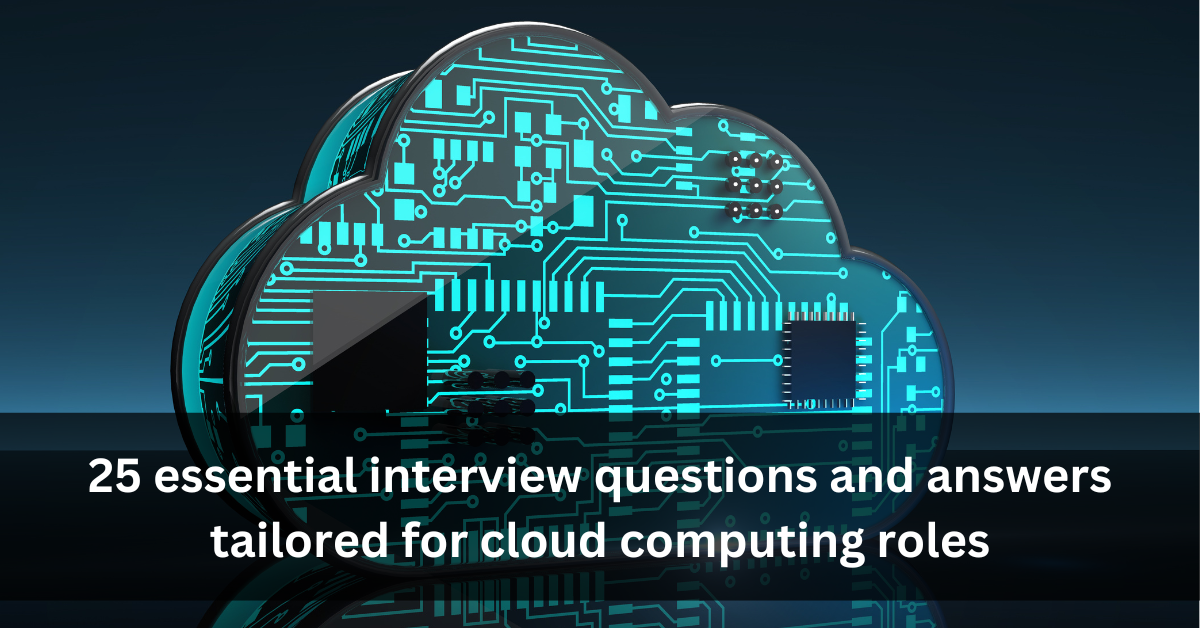25 Interview questions with answers for Cloud Computing Freshers role
In today’s digital age, cloud computing has become a cornerstone of modern IT infrastructure, transforming how businesses operate and innovate. As organizations increasingly migrate their operations to the cloud, the demand for skilled cloud computing professionals continues to grow. These experts are essential for designing, deploying, and managing cloud environments, ensuring that companies can leverage the full potential of cloud technology.
This article presents 25 essential interview questions and answers tailored for cloud computing roles. These questions cover fundamental concepts, advanced techniques, and practical scenarios, providing a comprehensive overview of the knowledge and skills required for a career in cloud computing. Whether you’re a hiring manager seeking to evaluate potential candidates or an aspiring cloud professional preparing for an interview, this guide will help you navigate the critical aspects of cloud computing and assess expertise in this dynamic field.
1. What is Cloud Computing?
Answer: Cloud computing is the delivery of computing services such as servers, storage, databases, networking, software, analytics, and intelligence over the internet (the cloud) to offer faster innovation, flexible resources, and economies of scale. Users typically pay only for the cloud services they use, helping lower operating costs, run infrastructure more efficiently, and scale as business needs change.
2. What are the different types of cloud deployment models?
Answer: The main cloud deployment models are:
- Public Cloud: Services are delivered over the public internet and shared across organizations.
- Private Cloud: Services are maintained on a private network and used exclusively by a single organization.
- Hybrid Cloud: Combines public and private clouds, allowing data and applications to be shared between them.
3. What are the primary benefits of using cloud computing?
Answer: The primary benefits include:
- Cost Efficiency: Reduces capital expenses since resources are rented rather than purchased.
- Scalability: Easily scale up or down based on demand.
- Flexibility: Access resources and services as needed.
- Disaster Recovery: Simplifies and enhances data recovery processes.
- Automatic Updates: Providers handle updates and security patches.
4. Explain the difference between IaaS, PaaS, and SaaS.
Answer:
- IaaS (Infrastructure as a Service): Provides virtualized computing resources over the internet (e.g., AWS EC2).
- PaaS (Platform as a Service): Offers hardware and software tools over the internet, usually for application development (e.g., Google App Engine).
- SaaS (Software as a Service): Delivers software applications over the internet, on a subscription basis (e.g., Salesforce).
5. What is a Virtual Private Cloud (VPC)?
Answer: A Virtual Private Cloud (VPC) is a secure, isolated private cloud hosted within a public cloud. It allows users to have a private network in the cloud, which they can control entirely, including IP addresses, subnets, route tables, and network gateways, ensuring secure and flexible cloud infrastructure.
6. What is autoscaling in cloud computing?
Answer: Autoscaling is a cloud computing feature that automatically adjusts the number of active servers and resources allocated to an application based on current demand. It ensures applications maintain performance and cost-efficiency by scaling up during high demand and scaling down during low demand.
7. What are the security risks associated with cloud computing?
Answer: Security risks include:
- Data Breaches: Unauthorized access to sensitive data.
- Data Loss: Data corruption or unavailability.
- Account Hijacking: Unauthorized access to cloud accounts.
- Insider Threats: Malicious activities by internal users.
- Insecure APIs: Vulnerabilities in cloud interfaces.
8. What is serverless computing?
Answer: Serverless computing allows developers to build and run applications without managing server infrastructure. Cloud providers dynamically allocate resources and charge based on the actual usage rather than pre-purchased capacity, facilitating scalable and efficient resource utilization (e.g., AWS Lambda).
9. What is a cloud service model?
Answer: A cloud service model defines how services are delivered and consumed in the cloud. The primary models include IaaS, PaaS, and SaaS, each offering different levels of control, flexibility, and management responsibilities to the users, depending on their specific needs and use cases.
10. What are cloud-native applications?
Answer: Cloud-native applications are designed and built to leverage cloud computing frameworks and services. They typically use microservices architecture, containerization, continuous integration/continuous deployment (CI/CD), and automated management to achieve scalability, resilience, and faster development cycles.
11. Explain the concept of multi-tenancy.
Answer: Multi-tenancy refers to a cloud computing architecture where multiple customers (tenants) share the same computing resources (e.g., servers, storage) in a single instance while keeping their data isolated. This approach maximizes resource utilization, reduces costs, and ensures efficient resource allocation.
12. What is a CDN, and how does it benefit cloud computing?
Answer: A Content Delivery Network (CDN) is a network of distributed servers that deliver web content and resources to users based on their geographic location. CDNs enhance cloud computing by reducing latency, improving load times, and providing high availability and redundancy for web applications.
13. What are containers, and how are they used in cloud computing?
Answer: Containers are lightweight, portable units that package an application and its dependencies, ensuring it runs consistently across different environments. In cloud computing, containers facilitate rapid deployment, scaling, and management of applications, enabling efficient use of resources and simplifying DevOps practices (e.g., Docker, Kubernetes).
14. What is cloud migration?
Answer: Cloud migration is the process of moving data, applications, and IT resources from on-premises infrastructure or other clouds to a cloud computing environment. This transition aims to leverage the benefits of cloud computing, such as scalability, cost savings, and improved performance.
15. What is the role of an API in cloud computing?
Answer: APIs (Application Programming Interfaces) allow different software applications to communicate and interact with cloud services. In cloud computing, APIs enable seamless integration, automation, and management of cloud resources, simplifying tasks like provisioning, scaling, and monitoring.
16. What are microservices?
Answer: Microservices is an architectural style that structures an application as a collection of loosely coupled, independently deployable services. Each service represents a specific business functionality, allowing for easier development, scaling, and maintenance, especially in cloud-native applications.
17. What is a hypervisor?
Answer: A hypervisor is software that creates and manages virtual machines (VMs) by abstracting the underlying hardware. It allows multiple VMs to run on a single physical machine, enabling efficient resource utilization and isolation of applications (e.g., VMware ESXi, Microsoft Hyper-V).
18. What is DevOps, and how is it related to cloud computing?
Answer: DevOps is a set of practices that combines software development (Dev) and IT operations (Ops) to shorten the development lifecycle and deliver high-quality software continuously. Cloud computing complements DevOps by providing scalable infrastructure, automation tools, and continuous integration/continuous deployment (CI/CD) capabilities.
19. What is load balancing in the cloud?
Answer: Load balancing distributes incoming network traffic across multiple servers to ensure no single server becomes overwhelmed. In the cloud, load balancing enhances application availability, reliability, and performance by evenly distributing the load and automatically scaling resources based on demand.
20. What are cloud orchestration tools?
Answer: Cloud orchestration tools automate the management, coordination, and organization of cloud services. They help deploy, manage, and integrate complex cloud environments, ensuring efficient resource utilization, consistency, and compliance (e.g., Kubernetes, AWS CloudFormation).
21. What is cloud elasticity?
Answer: Cloud elasticity is the ability to dynamically scale computing resources up or down in response to changing demand. It ensures that applications can handle varying workloads efficiently, maintaining performance while optimizing costs by allocating resources as needed.
22. What is a Service Level Agreement (SLA) in cloud computing?
Answer: An SLA is a formal contract between a cloud service provider and a customer that defines the expected level of service, performance metrics, and responsibilities. It typically includes uptime guarantees, response times, and penalties for non-compliance, ensuring accountability and reliability.
23. What are the key considerations for cloud cost management?
Answer: Key considerations include:
- Resource Optimization: Regularly assess and optimize resource usage.
- Budgeting and Forecasting: Plan and track cloud spending.
- Cost Allocation: Attribute costs to specific projects or departments.
- Rightsizing: Adjust resource sizes to match workload requirements.
- Utilizing Discounts: Leverage reserved instances, spot instances, and volume discounts.
24. What is Infrastructure as Code (IaC)?
Answer: IaC is a practice where infrastructure is managed and provisioned using code and automated scripts, rather than manual processes. It enables version control, consistency, and repeatability in deploying and managing cloud infrastructure, enhancing agility and reducing errors (e.g., Terraform, AWS CloudFormation).
25. What is a Cloud Service Broker (CSB)?
Answer: A Cloud Service Broker acts as an intermediary between cloud service providers and consumers, helping organizations select, manage, and integrate cloud services. CSBs provide value-added services such as aggregation, customization, and governance, ensuring efficient and effective cloud adoption.
If you are looking for azure cloud computing training you cam visit here

Cybersecurity Architect | Cloud-Native Defense | AI/ML Security | DevSecOps
With over 23 years of experience in cybersecurity, I specialize in building resilient, zero-trust digital ecosystems across multi-cloud (AWS, Azure, GCP) and Kubernetes (EKS, AKS, GKE) environments. My journey began in network security—firewalls, IDS/IPS—and expanded into Linux/Windows hardening, IAM, and DevSecOps automation using Terraform, GitLab CI/CD, and policy-as-code tools like OPA and Checkov.
Today, my focus is on securing AI/ML adoption through MLSecOps, protecting models from adversarial attacks with tools like Robust Intelligence and Microsoft Counterfit. I integrate AISecOps for threat detection (Darktrace, Microsoft Security Copilot) and automate incident response with forensics-driven workflows (Elastic SIEM, TheHive).
Whether it’s hardening cloud-native stacks, embedding security into CI/CD pipelines, or safeguarding AI systems, I bridge the gap between security and innovation—ensuring defense scales with speed.
Let’s connect and discuss the future of secure, intelligent infrastructure.
